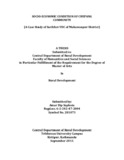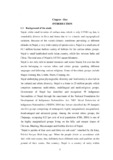Please use this identifier to cite or link to this item:
https://elibrary.tucl.edu.np/handle/123456789/814| Title: | Socio-Economic Condition of Chepang Community (A Case Study of Sarikhet Vdc of Makawanpur District) |
| Authors: | Sapkota, Amar Dip |
| Keywords: | economic condition;Chepang community |
| Issue Date: | Sep-2011 |
| Publisher: | Department of Rural Development |
| Institute Name: | Central Department of Rural Development |
| Level: | Masters |
| Abstract: | The research is descriptive and explanatory in nature. The study has assessed the overall status of the Chepangs of Sarikhet VDC, Makawanpur. Interviews were taken with the selected samples of the elderly. An attempt was also made to look into their problems through interactions, and observations the random sampling method was adopted to select the respondents, and they were asked semi-structured questions. The findings taken from the research were interpreted, and recommendations were made accordingly. Chepang have been considered as one of the indigenous groups of Nepal. The census of 2002 has revealed that the population of Chepang is 52,237. The Chepangs have their own language, which belongs to the Tibeto-Burman family. The Chepang language is close to languages of Thami and Hayu. The Chepangs mostly bury their dead body. The dead body is bathed and new clothes and garlands of flower are put on the body and wrapped with burial cloth. A box is made of the barks of sal, in which the dead body is kept and buried. Chepangs are two types, viz Pukunthae and Kachhare. It is a matter of fact that in the past Chepangs were living in isolation and roaming like nomads having no contacts with the outside world. However, with the passage of time they have been improving themselves and developing relationship with other people and have been living in the society. The influence of modernization has less effect on their life. There lies abject poverty among the Chepangs in the study site. Still they rely on wild food to solve their hand to mouth problems. Nearly 42% of the respondents were found married at early age. Similarly, the education level of the respondents was also found very low. About 64.28% of the male respondents were illiterate followed by 83.33% female. Majority of the respondents were found holding agriculture as their major occupation. While assessing the religion of the respondents, about 49% of the respondents were found Hindu, 31% Buddhist and the rest 20% Christians. They were found living with meager income. Very few of the respondents had knowledge of family planning awareness. Similarly, majority of the respondents were found discriminated by the elites giving a loan and exploiting labor, the people of higher castes and some of them were found discriminated on charges of untouchability. Very few of the respondents were found holding sufficient land for food production. The food produced in their land is not sufficient land is not sufficient to run their livelihood even for the period of half a year. Chonam, Dashain, Tihar, Maghesakranti and Saune sanessakranti are the major festivals that are celebrated by the Chepangs. Hence, to overcome the problems of Chepangs and increase their living standard, their indigenous settlement must be protected and secured. Special measures must be adopted by the government to control the out migration of the Chepangs. Similarly, special quota should be allotted for Chepangs in the sectors like education, health, job, etc to increase their living standard and broaden their outlook. Chepangs are still not consulted in decision-making process at the localand national level. Hence, their participation is essential to make any program related to them success. Participatory management approach should be applied in the study site to make any program related to Chepangs a sustainable and durable one |
| URI: | http://elibrary.tucl.edu.np/handle/123456789/814 |
| Appears in Collections: | Rural Development |
Files in This Item:
| File | Description | Size | Format | |
|---|---|---|---|---|
| cover.pdf | 46.75 kB | Adobe PDF |  View/Open | |
| Chapter(1).pdf | 200.83 kB | Adobe PDF |  View/Open |
Items in DSpace are protected by copyright, with all rights reserved, unless otherwise indicated.
